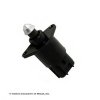I re-read the posts again and watched the videos, which helped. As I understand, ever thing you have done has had negligible results solving the problem, correct?
Side note - I can’t believe that the candoo cannot be used while the engine is running to monitor different aspects, seems like that would be a key advantage to having a diagnostic tool such as that. I feel that I have heard of others using it while the engine was running. Have you tried contacting them to find out for sure, people say that their customer support for the product is good.
Back to the issue at hand…port engine:
Seems to start and idle perfect but will not increase speed smoothly. I noticed that engine will jump from idle to about 6000, seems there is no way to smoothly and slowly increase rpms. Is this true for the whole rpm range? In other words if you slowly advance the throttle, is there any rpm range that is consistently not smooth or consistently smooth? Is the engine rpm more controllable in the higher range more so than lower range? I am guessing the answer is no, and that the engine is equally choppy no matter where you advance the throttle from or where you stop.
If so I have a theory that there may be some type of mechanical issue with the throttle either from a gummed up throttle body (unlikely) or a broken throttle cable. From what I witnessed in the video seems like the throttle is on a rubber band, you increase throttle and nothing happens until –bam- it snaps back and rpm’s jump rapidly. On a car I have witnessed this if it is gummed up, takes lots of pressure to move the butterfly and it suddenly then snaps open near half throttle. If the cable sheath is impaired (either at throttle levers or throttle body) it can act kind of like this. It would also behave differently when not started (not under load) and when running (under load of vacuum pressure). Simple test would be to stick your hand into the throttle body (engine not running) and put some pressure on the butterfly valve with your fingers, ask someone else to slowly increase throttle while you feel if there is any play or if the butterfly moves smoothly in relation to the throttle even with pressure applied. Any detectable play in the cable? May want to inspect the cable at the throttle levers too.
Kind of a shot in the dark and a way out theory, but all I can think of right now. As for your question about the idle control valve, it does not seem like it can cause this type of issue. The IDC really only affects idle, that’s it. Since the boat starts and idles perfect then it is unlikely to be bad. It is simply a small servo motor that controls a trap door on the side of the throttle body to let air in and control idle when the main throttle butterfly is closed. The computer controlled motor opens and closes the idle butterfly to keep engine idle constant regardless of load, temp, etc. It seems to be doing that so probably not the problem. The other sensors in the throttle body can be hard to test, especially the MAP. Usually if the MAP is bad then there are significant runability issues and you will get a check engine light. Since you have swapped/replaced just about everything else it seems very likely something to do with the throttle body.
Sorry if this does not help much, if I come up with any other nutty ideas I will let you know!












